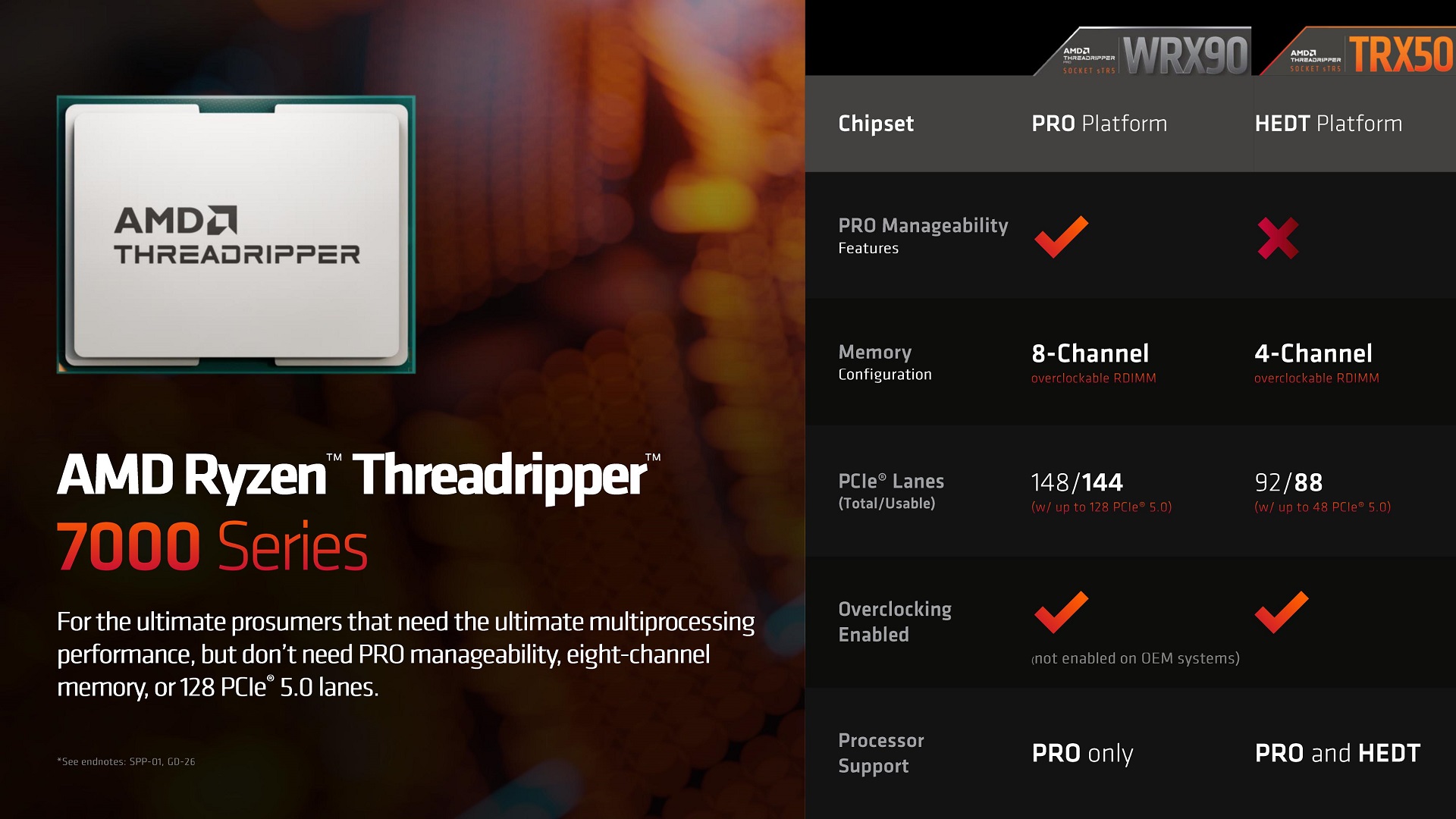Tech
AMD Ryzen Threadripper 7980X & 7970X Review: Revived HEDT Brings More Cores of Zen 4

AMD’s Ryzen Threadripper 7000 processors mark the latest additions to the high-end desktop (HEDT) market, a segment AMD wants to bring back to the mainstream. Based on AMD’s proven Zen 4 architecture and built on TSMC’s 5nm process, both of AMD’s new Ryzen Threadripper 7000 lineups – Pro and non-Pro – are designed to bring more cores and more I/O to the high-end desktop and workstation markets. Altogether, AMD is offering three new Ryzen Threadripper 7000 SKUs, the top-end 7980X with 64 cores, the mid-tier 7970X with 32 cores, and the entry-level chip in the line-up, the 24-core 7960X.
As has been the case for the vanilla Threadripper series since its inception, the purpose of AMD’s server-derived processors is to meet the demands of desktop users who require extreme multitasking capabilities and high throughput for complex workloads, offering more CPU cores, more memory channels, and more PCIe lanes than what otherwise comes with AMD’s desktop platform. At the same time, the basic Threadripper lineup differentiates itself from the professional workstation-focused Threadripper Pro chips – in this case, AMD’s new Threadripper 7000 WX-series – by leaving out some of the more ‘Pro’ features that come with that hardware, as well as some of the CPU/memory/IO hardware that the even more powerful Pro chips offer. Segmenting both product lines is a good idea, given the pedigree and use cases of both the Pro WX-series and non-Pro chips are aligned with. With Threadripper 7000, AMD targets customer bases that need CPUs more powerful than a desktop Ryzen processor but not as exotic (or expensive) as what’s essentially a full server-grade chip.
After taking a break in the previous generation, AMD is once again offering a HEDT-focused line-up to consumers, which is as grandiose as it is interesting. When AMD launched the Zen 3-based Threadripper 5000 series, AMD only ever released the workstation-focused Pro parts, leaving users looking for semi-affordable high-core count CPUs in the dust. This time, AMD has decided to bring the HEDT back, creating a pair of Threadripper lines similar to the Threadripper 3000 family in 2019.
Today in our AMD Ryzen Threadripper 7000 series review, we’re going to be focusing on the top two chips from the trifecta, the top-end Ryzen Threadripper 7980X (64C/128T) and the middle of the road 7970X (32C/64T). We’ll be comparing them to the previous Ryzen Threadripper 3000 series and directly against Intel’s Sapphire Rapids Workstation CPUs, including the flagship Intel Xeon w9-3495X. Also, we’ll be putting them against the desktop flagships, such as the Intel Core i9-14900K and the AMD Ryzen 9 7950X, to see how much more performance AMD’s new foray into HEDT users can squeeze out. Is there a suitable place in the market for HEDT chips, given how far desktop processors have progressed within the last couple of years? Let’s find out.
After AMD skipped releasing a vanilla Threadripper processor as part of their Zen 3 architecture family – what would have been the Ryzen Threadripper 5000 series – things certainly looked dim for the future of the high-end desktop (HEDT) market. Combined with Intel also skipping HEDT that generation by not bringing down their troubled Ice Lake server silicon to HEDT products, and it was looking like HEDT may have finally been pushed out by more powerful desktop processors. But a generation later, and things have seemingly changed for the better for the HEDT market. Looking to further capitalize on the success of their Zen 4 architecture, AMD is bringing back HEDT models to the market via the Threadripper 7000 series, with three new chips ranging up to 64C/128T, all with full Zen 4 cores.
The AMD Ryzen Threadripper 7980X, 7970X, and 7960X are the latest entries in the HEDT market, bringing significant advancements in processing power and efficiency. The 7980X is the top SKU with 64 cores/128 threads, a turbo clock speed of up to 5.1 GHz, and a base clock of 2.5 GHz. The 7970X has half the cores and threads, for 32 cores/64 threads altogether, and offers a higher base frequency of 3.2 GHz and matches its higher-end counterpart’s 5.1 GHz turbo clock.
AMD Ryzen Threadripper 7980X (64C/128T) CPU-Z Screenshot
These chips are aimed at driving demanding multi-threaded applications that can saturate high core count CPUs, such as advanced content creation, 3D rendering, and complex computational tasks. The 7980X, the more powerful of the two, is particularly suited for scenarios requiring extreme multitasking and high throughput.
Conversely, though AMD isn’t sampling it for today’s review embargo, the Threadripper 7960X represents the other side of the coin. With 24 cores/48 threads, a base frequency of 3.2 GHz and a turbo clock speed of up to 5.3 GHz, the 7960X offers the fewest cores, but still all of the memory bandwidth and I/O lanes the Threadripper platform can provide, making it especially well suited for tasks where data throughput rather than raw CPU performance is the bottleneck. Still, with fewer CPU cores, it’s the entry-level part (if you can call it that) to AMD’s new HEDT platform, with an MSRP of $1499.
| AMD Ryzen Threadripper 7000 (Zen 4) | ||||||||
| AnandTech | Cores | Base Freq |
Turbo Freq |
PCIe (Gen 5) |
Cache (L3) |
TDP | DRAM (RDIMM) |
Price ($) |
| 7980X | 64 / 128 | 2500 | 5100 | 48 | 256 MB | 350W | 4 x DDR5-5200 | $4999 |
| 7970X | 32 / 64 | 3200 | 5100 | 48 | 128 MB | 350W | 4 x DDR5-5200 | $2499 |
| 7960X | 24 / 48 | 3200 | 5300 | 48 | 128 MB | 350W | 4 x DDR5-5200 | $1499 |
Regarding memory and I/O capabilities, the Threadripper 7000 series supports quad-channel DDR5 memory and up to 48 PCIe 5.0 lanes, offering plenty of bandwidth for devices such as storage and graphics. Unique to the Threadripper 7000 platform (versus AMD’s consumer platform), AMD supports RDIMMs here, allowing the for support for up to 1 TB of memory via DDR-5200 RDIMMs – over 5x as much memory as desktop Ryzen.
These processors represent AMD’s commitment to pushing the capability of desktop computing power, catering to both professionals, enthusiasts, and everything in between. They are designed for users who require more than what standard desktop CPUs can offer. The Ryzen Threadripper 7980X and 7970X are designed to excel in multi-threaded workloads. Their theoretical ability to handle more diverse and intensive workloads than desktop processors makes them a pivotal choice in the current HEDT landscape.
One step above this is the Threadripper 7000 Pro WX series, which has support for 8 channels of memory, pushing the performance where workloads, instruction sets, and applications can benefit from both more memory bandwidth and higher memory densities.
The TRX50 Chipset: Designed For Threadripper 7000, Supports TR Pro 7000 WX-Series
Launching alongside the new Threadripper chips is AMD’s TRX50 chipset. The TRX50 platofrm uses the new 4844 pins sTR5 socket, which like the Threadripper processors themselves, is derived from AMD’s EPYC offerings – in this case the SP6 socket AMD introduced for their lower-priced EPYC 8004 (Siena) processors. Despite the identical pin count, it should be noted that sTR5 and SP6 are not pin compatible.
Meanwhile, looking at things on a generational basis, there is a degree of cooler compatibility. Specifically, older socket sTRX4 Threadripper coolers will still fit on the 58.5mm x 75.4mm sTR5 socket. This means users upgrading from sTRX4 chips should theoretically be able to recycle their old cooler. However, they would certainly need to be capable of supporting a higher TDP of 350 W.
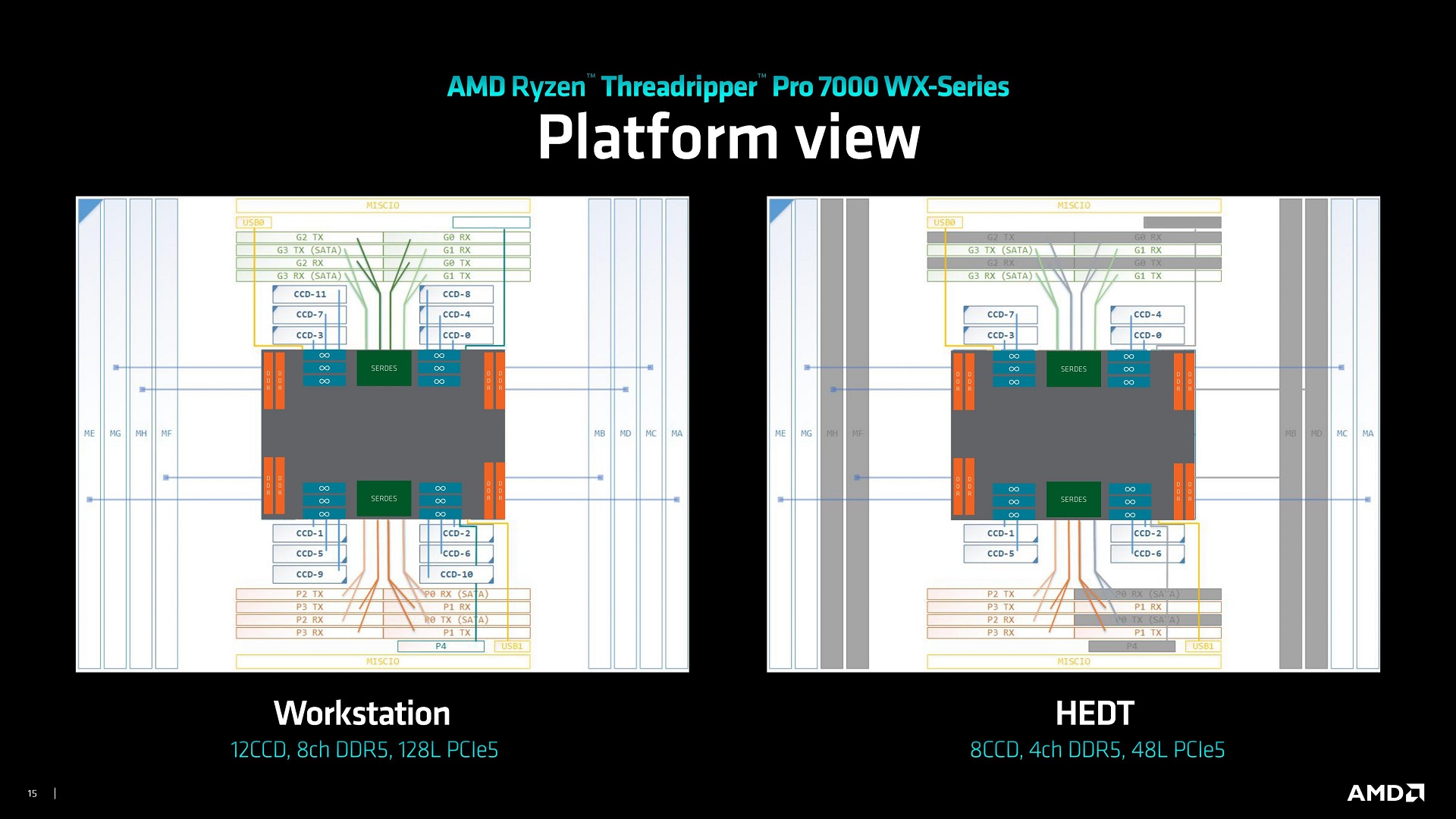
Platform diagram of the WRX90 (left) and TRX50 (right)
For memory and I/O, the TRX50 platform supports 4-channel DDR5 memory and 80 PCIe lanes. Though the latter ends up being an unexpected mix of PCIe 5.0 lanes and PCIe 4.0 lanes, with 48x PCIe 5.0 lanes alongside a further 32x PCIe 4.0 lanes. As PCIe Gen5 is more complex to implement and longer runs require re-drivers, AMD has opted to limit the manufacturing costs of motherboards by not running quite so many max-speed PCIe lanes. At the same time, the idea of TRX50, especially when directly compared to WRX90 for Threadripper Pro 7000 WX-series chips, is that it is a cut-down version to provide everything users need on a middle-abridged chipset between desktop AM5 and WRX90 – meaning that dialing back some PCIe lanes to 4.0 also provides some feature differentiation between the two Threadripper lineups.
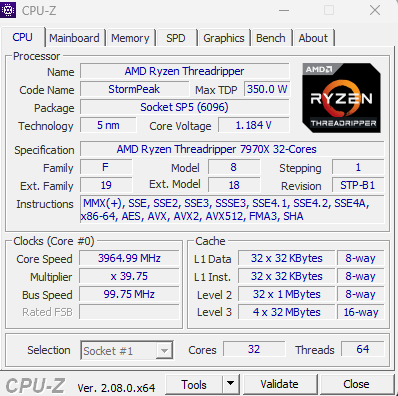
AMD Ryzen Threadripper 7970X (32C/64T) CPU-Z Screenshot
It is worth highlighting that Threadripper 7000 Pro chips can also be used in TRX50 motherboards. But, of course, they will be subjected to the same memory channel and I/O limitations. In that respect, TRX50 boards can be used as a budget board pairing for Threadripper Pro chips. Otherwise, the converse is false: non-pro Threadripper 7000 chips cannot be used in WRX90 boards, as illogical as that would be.
Test Bed and Setup
We use the following test systems for our AMD Ryzen Threadripper 7980X, 7970X, and Intel Xeon WS-series testing:
| AMD Ryzen Threadripper 7000 Series | Intel Sapphire Rapids Xeon Series | |
| CPU | Ryzen Threadripper 7980X ($4999) 64 Cores, 128 Threads 350 W TDP Ryzen Threadripper 7970X ($2499) |
Xeon W9-3495X ($5889) 56 Cores, 112 Threads 350 W TDP |
| Motherboard | ASUS Pro WS TRX50-SAGE WIFI | ASUS Pro WS W790E-SAGE SE |
| Memory | G.Skill Zeta R5 Neo 4×32 GB DDR5-5200 RDIMM |
SK Hynix 8×16 GB DDR5-4800 RDIMM |
| 6 | NZXT Kraken 360 360mm AIO | Noctua NH-U14S DX-4677 |
| Storage | SK Hynix Platinum P41 2TB PCIe 4.0 x4 | |
| Power Supply | MSI A1000G 1000W | |
| GPUs | AMD Radeon RX 6950 XT, 31.0.12019 | |
| Operating Systems | Windows 11 22H2 | |
For our head-to-head comparison, we have on hand Intel’s latest Sapphire Rapids Xeons. Like the Threadripper series, the Xeons are split up into two sub-groups – the full-fat Xeon w-3000 series for high-end workstations, and the lighter Xeon w-2000 series for more mainstream workstations. Unfortunately, the only Xeons we have on hand are the w-3000 series parts (which is what Intel sampled for reviewing when those were released), so it’s not quite an apples-to-apples comparison, especially as the w-3000 Xeons support 8 channels of memory (versus TR’s 4 channels).
Still, there are similarities in core and thread count and TDP that should offer some enlightening data. Both platforms have a max TDP of 350W, and the Intel W9-3495X we’re using is a 56C/112T chip, while the Threadripper 7980X is a 64C/128T chip.
For added flavor, we’ll be adding in data from both AMD and Intel’s flagship desktop processors, including the Core i9-14900K, the Ryzen 9 7950X, and Ryzen 9 7950X3D. We will also be comparing the new AMD Threadripper 7000 series chips to their previous counterparts, including the AMD Ryzen Threadripper 3990X (64C/128T), which we reviewed in 2020, as well as the Threadripper 3970X (32C/64T).

Tech
How to Preorder the PlayStation 5 Pro in Canada

Sony has made it easy for Canadian consumers to preorder the PlayStation 5 Pro in Canada directly from PlayStation’s official website. Here’s how:
- Visit the Official Website: Go to direct.playstation.com and navigate to the PS5 Pro section once preorders go live on September 26, 2024.
- Create or Log in to Your PlayStation Account: If you don’t have a PlayStation account, you will need to create one. Existing users can simply log in to proceed.
- Place Your Preorder: Once logged in, follow the instructions to preorder your PS5 Pro. Ensure you have a valid payment method ready and double-check your shipping information for accuracy.
Preorder Through Major Canadian Retailers
While preordering directly from PlayStation is a popular option, you can also secure your PS5 Pro through trusted Canadian retailers. These retailers are expected to offer preorders on or after September 26:
- Best Buy Canada
- Walmart Canada
- EB Games (GameStop)
- Amazon Canada
- The Source
Steps to Preorder via Canadian Retailers:
- Visit Retailer Websites: Search for “PlayStation 5 Pro” on the website of your preferred retailer starting on September 26.
- Create or Log in to Your Account: If you’re shopping online, having an account with the retailer can speed up the preorder process.
- Preorder in Store: For those who prefer in-person shopping, check with local stores regarding availability and preorder policies.
3. Sign Up for Notifications
Many retailers and websites offer the option to sign up for notifications when the preorder goes live. If you’re worried about missing out due to high demand, this can be a useful option.
- Visit Retailer Sites: Look for a “Notify Me” or “Email Alerts” option and enter your email to stay informed.
- Use PlayStation Alerts: Sign up for notifications directly through Sony to be one of the first to know when preorders are available.
4. Prepare for High Demand
Preordering the PS5 Pro is expected to be competitive, with high demand likely to result in quick sellouts, just as with the initial release of the original PS5. To maximize your chances of securing a preorder:
- Act Quickly: Be prepared to place your order as soon as preorders open. Timing is key, as stock can run out within minutes.
- Double-Check Payment Information: Ensure your credit card or payment method is ready to go. Any delays during the checkout process could result in losing your spot.
- Stay Informed: Monitor PlayStation and retailer websites for updates on restocks or additional preorder windows.
Final Thoughts
The PlayStation 5 Pro is set to take gaming to the next level with its enhanced performance, graphics, and new features. Canadian gamers should be ready to act fast when preorders open on September 26, 2024, to secure their console ahead of the holiday season. Whether you choose to preorder through PlayStation’s official website or your preferred retailer, following the steps outlined above will help ensure a smooth and successful preorder experience.
For more details on the PS5 Pro and to preorder, visit direct.playstation.com or stay tuned to updates from major Canadian retailers.
Tech
Introducing the PlayStation 5 Pro: The Next Evolution in Gaming

Since the PlayStation 5 (PS5) launched four years ago, PlayStation has continuously evolved to meet the demands of its players. Today, we are excited to announce the next step in this journey: the PlayStation 5 Pro. Designed for the most dedicated players and game creators, the PS5 Pro brings groundbreaking advancements in gaming hardware, raising the bar for what’s possible.
Key Features of the PS5 Pro
The PS5 Pro comes equipped with several key performance enhancements, addressing the requests of gamers for smoother, higher-quality graphics at a consistent 60 frames per second (FPS). The console’s standout features include:
- Upgraded GPU: The PS5 Pro’s GPU boasts 67% more Compute Units than the current PS5, combined with 28% faster memory. This allows for up to 45% faster rendering speeds, ensuring a smoother gaming experience.
- Advanced Ray Tracing: Ray tracing capabilities have been significantly enhanced, with reflections and refractions of light being processed at double or triple the speed of the current PS5, creating more dynamic visuals.
- AI-Driven Upscaling: Introducing PlayStation Spectral Super Resolution, an AI-based upscaling technology that adds extraordinary detail to images, resulting in sharper image clarity.
- Backward Compatibility & Game Boost: More than 8,500 PS4 games playable on PS5 Pro will benefit from PS5 Pro Game Boost, stabilizing or enhancing performance. PS4 games will also see improved resolution on select titles.
- VRR & 8K Support: The PS5 Pro supports Variable Refresh Rate (VRR) and 8K gaming for the ultimate visual experience, while also launching with the latest wireless technology, Wi-Fi 7, in supported regions.
Optimized Games & Patches
Game creators have quickly embraced the new technology that comes with the PS5 Pro. Many games will receive free updates to take full advantage of the console’s new features, labeled as PS5 Pro Enhanced. Some of the highly anticipated titles include:
- Alan Wake 2
- Assassin’s Creed: Shadows
- Demon’s Souls
- Dragon’s Dogma 2
- Final Fantasy 7 Rebirth
- Gran Turismo 7
- Marvel’s Spider-Man 2
- Ratchet & Clank: Rift Apart
- Horizon Forbidden West
These updates will allow players to experience their favorite games at a higher fidelity, taking full advantage of the console’s improved graphics and performance.
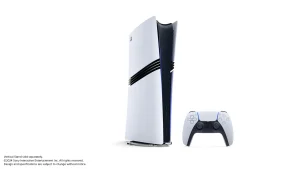
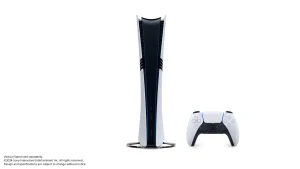

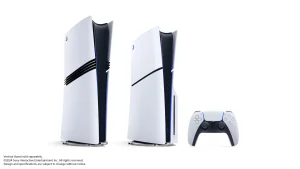


Design & Compatibility
Maintaining consistency within the PS5 family, the PS5 Pro retains the same height and width as the original PS5 model. Players will also have the option to add an Ultra HD Blu-ray Disc Drive or swap console covers when available.
Additionally, the PS5 Pro is fully compatible with all existing PS5 accessories, including the PlayStation VR2, DualSense Edge, Pulse Elite, and Access controller. This ensures seamless integration into your current gaming setup.
Pricing & Availability
The PS5 Pro will be available starting November 7, 2024, at a manufacturer’s suggested retail price (MSRP) of:
- $699.99 USD
- $949.99 CAD
- £699.99 GBP
- €799.99 EUR
- ¥119,980 JPY
Each PS5 Pro comes with a 2TB SSD, a DualSense wireless controller, and a copy of Astro’s Playroom pre-installed. Pre-orders begin on September 26, 2024, and the console will be available at participating retailers and directly from PlayStation via direct.playstation.com.
The launch of the PS5 Pro marks a new chapter in PlayStation’s commitment to delivering cutting-edge gaming experiences. Whether players choose the standard PS5 or the PS5 Pro, PlayStation aims to provide the best possible gaming experience for everyone.
Preorder your PS5 Pro and step into the next generation of gaming this holiday season.
Tech
Google Unveils AI-Powered Pixel 9 Lineup Ahead of Apple’s iPhone 16 Release
Google has launched its next generation of Pixel phones, setting the stage for a head-to-head competition with Apple as both tech giants aim to integrate more advanced artificial intelligence (AI) features into their flagship devices. The unveiling took place near Google’s Mountain View headquarters, marking an early debut for the Pixel 9 lineup, which is designed to showcase the latest advancements in AI technology.
The Pixel 9 series, although a minor player in global smartphone sales, is a crucial platform for Google to demonstrate the cutting-edge capabilities of its Android operating system. With AI at the core of its strategy, Google is positioning the Pixel 9 phones as vessels for the transformative potential of AI, a trend that is expected to revolutionize the way people interact with technology.
Rick Osterloh, Google’s senior vice president overseeing the Pixel phones, emphasized the company’s commitment to AI, stating, “We are obsessed with the idea that AI can make life easier and more productive for people.” This echoes the narrative Apple is likely to push when it unveils its iPhone 16, which is also expected to feature advanced AI capabilities.
The Pixel 9 lineup will be the first to fully integrate Google’s Gemini AI technology, designed to enhance user experience through more natural, conversational interactions. The Gemini assistant, which features 10 different human-like voices, can perform a wide array of tasks, particularly if users allow access to their emails and documents.
In an on-stage demonstration, the Gemini assistant showcased its ability to generate creative ideas and even analyze images, although it did experience some hiccups when asked to identify a concert poster for singer Sabrina Carpenter.
To support these AI-driven features, Google has equipped the Pixel 9 with a special chip that enables many AI processes to be handled directly on the device. This not only improves performance but also enhances user privacy and security by reducing the need to send data to remote servers.
Google’s aggressive push into AI with the Pixel 9 comes as Apple prepares to unveil its iPhone 16, which is expected to feature its own AI advancements. However, Google’s decision to offer a one-year free subscription to its advanced Gemini Assistant, valued at $240, may pressure Apple to reconsider any plans to charge for its AI services.
The standard Pixel 9 will be priced at $800, a $100 increase from last year, while the Pixel 9 Pro will range between $1,000 and $1,100, depending on the model. Google also announced the next iteration of its foldable Pixel phone, priced at $1,800.
In addition to the new Pixel phones, Google also revealed updates to its Pixel Watch and wireless earbuds, directly challenging Apple’s dominance in the wearable tech market. These products, like the Pixel 9, are designed to integrate seamlessly with Google’s AI-driven ecosystem.
Google’s event took place against the backdrop of a significant legal challenge, with a judge recently ruling that its search engine constitutes an illegal monopoly. This ruling could lead to further court proceedings that may force Google to make significant changes to its business practices, potentially impacting its Android software or other key components of its $2 trillion empire.
Despite these legal hurdles, Google is pressing forward with its vision of an AI-powered future, using its latest devices to showcase what it believes will be the next big leap in technology. As the battle for AI supremacy heats up, consumers can expect both Google and Apple to push the boundaries of what their devices can do, making the choice between them more compelling than ever.
-

 News19 hours ago
News19 hours agoSingh claps back at Poilievre ahead of House return
-

 News18 hours ago
News18 hours agoMore than 67 million people watched Donald Trump and Kamala Harris debate. That’s way up from June
-

 News18 hours ago
News18 hours agoTaxi driver suspected in fatal B.C. hit-and-run has left Canada: RCMP
-

 News18 hours ago
News18 hours agoThe ancient jar smashed by a 4-year-old is back on display at an Israeli museum after repair
-

 News19 hours ago
News19 hours agoMounties say there’s no evidence Lytton, B.C., wildfire was arson; cause unknown
-
News6 hours ago
Local Toronto business story – Events Industry : new national brand, Element Event Solutions
-

 News7 hours ago
News7 hours agoReggie Bush was at his LA-area home when 3 male suspects attempted to break in
-

 News18 hours ago
News18 hours agoAlberta Premier Smith says she wants Calgary Green Line to proceed as first pitched

